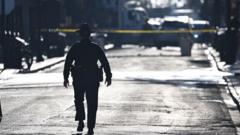The situation in New Orleans raises significant questions about the adequacy of urban security systems, especially in high-density tourist areas, and the effectiveness of preventative measures against similar threats.
Security Barriers Under Renovation Prior to Fatal New Orleans Attack

Security Barriers Under Renovation Prior to Fatal New Orleans Attack
Investigation reveals lack of functional security measures amid a tragic incident in the French Quarter that left multiple casualties.
On New Year's Day, a truck attack in New Orleans resulted in 14 fatalities and over 35 injuries, raising significant concerns regarding the city's security measures. Security barriers, known as bollards, were reportedly removed for repairs before the incident, which took place in a high-foot-traffic area of the French Quarter. Louisiana officials stated that these barriers were undergoing renovations ahead of the NFL Super Bowl scheduled for February 9. Christopher Raia, an FBI official, labeled the attack as terrorism. While a police vehicle was positioned to restrict access to Bourbon Street, the suspect managed to circumvent it, leading to a devastating outcome. Police have identified Shamsud-Din Jabbar, a 42-year-old veteran, as the perpetrator, who also died in the attack. Following the incident, New Orleans Police Chief Anne Kirkpatrick acknowledged existing plans to enhance security in the area, emphasizing the unexpected nature of the attack. Local officials have highlighted the historical use of bollards in New Orleans and the challenges posed by malfunctioning barriers from Mardi Gras debris. Experts noted that it remains uncertain whether more effective barriers would have changed the attack's outcome, citing the unpredictable nature of such incidents. A past report had identified the French Quarter as a potential terrorism target due to its dense pedestrian presence, reinforcing the need for continued scrutiny and improved safety measures.


















